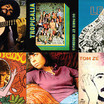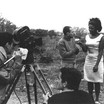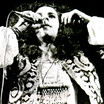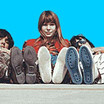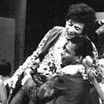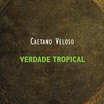Eubioticamente atraídos

tropicália modernity, allegory, and counterculture
Foreign views
TROPICÁLIA MODERNITY, ALLEGORY, AND COUNTERCULTURE
Christopher Dunn, Tulane University
An epochal crisis lies at the core of the extraordinary surge of invention and innovation in Brazilian popular music in the late 1960s. The protagonists of this creative flourish came of age during a period of great optimism based on the conviction that artists had a central role to play in the forging of a democratic, socially just, and modern nation. Many of these artists, however, initiated their careers precisely at the moment when Brazil’s experiment in democracy was eclipsed by a military coup that installed an authoritarian regime committed to a radically different model of modernization and development. This crisis produced a set of tensions that were dissected by a group of young artists from Bahia, the epicenter of Afro-Brazilian culture, and intellectual and artistic allies from São Paulo, the most urbanized and industrialized center of the nation. Two impulses, intertwined yet fundamentally distinct, oriented these artists who articulated a project under the name of Tropicália. Their principle song-manifestos were allegorical, presenting mournful accounts of national history often under the guise of irony and satire. Their most important performances, however, pointed in a new direction informed by international counterculture and charged with cathartic exuberance in the face of increasing repression. The tension between these two impulses produced a curious and potent mix of melancholy and joy that defined tropicalist music.
Brazilian Modernity and the Legacy of Bossa Nova
In a recent documentary Caetano Veloso remarked that Tropicália may be understood as the avesso da bossa, the “inverse” or “underside” of bossa nova, the musical style that emerged in the late 1950s in the bars and clubs of the south zone of Rio de Janeiro. The creation of bossa nova involved dozens of young musicians, but the key figures were composer and pianist Antonio Carlos Jobim, modernist poet and diplomat Vinícius de Moraes, and singer-guitarist João Gilberto who is credited with inventing the distinctive finger-plucking style and understated vocal style that in it most sublime moments seemed more like whispering. João Gilberto’s recording of the Jobim-Moraes tune “Chega de Saudade” launched the movement in 1958. Four years later, an entourage of Brazilian musicians showcased the new music to an enthusiastic audience at Carnegie hall. Jobim and Gilberto later joined saxophonist Stan Getz to record “The Girl from Ipanema, featuring Astrud Gilberto on vocals, which hit the U.S. pop charts in 1964.
With sophisticated harmonies informed by cool jazz and elegant poetry meditating on love and nature, bossa nova seemed to announce a distinctively Brazilian cultural modernity, at once cosmopolitan and rooted in the popular tradition of samba. The style was also linked, although never in programmatic fashion, to a period of optimism associated with presidency of Juscelino Kubitschek, a democratic populist committed to a program of national development, most dramatically symbolized by the rapid construction of the modernist capital, Brasília.
Just as bossa nova was attracting international interest, it was increasingly attacked at home by left-wing nationalists, many of whom admired its aesthetic achievements but criticized it for failing to register and denounce the country’s social ills, sustained in no small measure by its dependent and peripheral position in relation to centers of international capital, especially the United States. Young middle-class musicians, many of them bossa nova enthusiasts, increasingly sought ways achieve a more rustic, folksy sound by appropriating elements of urban samba and, most dramatically, popular music from the impoverished rural northeast. This tendency in popular music coincided with and corresponded to experiments in Cinema Novo and a radical popular theater. A culture of left-wing nationalism flourished under the government of João Goulart, who actively courted support from radicalized sectors of urban labor and student groups.
The turn toward a vocabulary of anti-imperialist cultural nationalism in popular music became more urgent following the military coup of April 1964, which brought to power a right-wing authoritarian regime allied with the United States. Exacerbating tensions within the field of popular music, the consolidation of military rule coincided with the popular success of a homegrown rock and roll phenomena dubbed iê-iê-iê and led by the telegenic crooner Roberto Carlos and featuring other performers identified collectively as the Jovem Guarda. In the mid-1960s, the electric guitar was a potent cultural diacritic, signifying for many exciting and modern international youth culture and for others an insidious icon of consumerist, imperialist culture from the United States. This period also saw the dramatic expansion of television, underwritten and promoted by the military regime, and the massive success of televised music festivals hosted by TV Record in São Paulo and TV Globo in Rio de Janeiro. These festivals were crucial in forging a new socio-aesthetic category of popular music coalescing under the rubric of Música Popular Brasileira, or simply MPB.
Stylistically, MPB was defined less by what it was not than by what it was. It was not rock, associated with an imported fad, nor was it traditional popular music most typically identified with urban samba or with various regional rural forms. It was, instead, a hybrid category that emerged from post-Bossa Nova sensibilities yet attendant to aesthetic values and social concerns linked to a national-popular imaginary. Its most basic operation was to fuse “tradition” with “modernity” without succumbing to the pressures of the emergent popularity of iê-iê-iê. Performing MPB for before live audiences of sympathetic university students took on symbolic value that transcended lyrical content, which rarely expressed anything more subversive than bland lamentations for the plight of urban laborers or northeastern peasants.
The group of musicians that would later launch the tropicalist revolution in popular music identified with MPB, yet maintained an ambivalent attitude toward the ideological apparatus that had formed around it. In a famous round table debate on popular music from 1965, Veloso complained of aesthetic limitations of post-bossa nova MPB, arguing for the retomada da linha evolutiva, or “return to the evolutionary line,” in Brazilian popular music as exemplified by João Gilberto and the first wave of Bossa Nova artists who had assimilated the techniques and insights of “musical modernity” (i.e. jazz) without anxiety about national authenticity.
Brazilian philosopher Antonio Cícero has provided a subtle reading of Veloso’s much debated argument, noting that the concept of “evolution” is problematic if read merely as a teleological statement implying qualitative improvement or advance toward a specific end. It is possible, however, to speak of evolution in terms of heightened technical or formal complexity in certain fields of artistic production. Yet the tropicalists did not introduce greater complexity to Brazilian popular music and certainly did not advance the formal evolution of bossa nova. Cícero reads Veloso’s statement, and by extension the tropicalist musical project, in terms of “conceptual elucidation,” a type of “evolution” that has nothing to do with degree of formal complexity.
The tropicalists redefined the very parameters of music-making, expanding the limits of the “popular” and paving the way for a new performative and sonorous experiments in Brazilian popular music. In this sense, the tropicalists were operating in the terrain explored by Marcel Duchamp, and later Andy Warhol, by reconfiguring the contours and limits of their artistic field. Closer to home, their music parelleled and at times intersected with the “ambient anti-art” of Hélio Oiticica who most radically transformed the status of the art object and its relation to the public.
Central to the tropicalist project of “conceptual elucidatation” was the appropriation of international rock and pop, inspired in part by the Jovem Guarda. Here we get closer to the meaning of Veloso’s understanding of Tropicália as the avesso da bossa. The tropicalists revered the original inventors of bossa nova and were indebted to their modern cosmopolitan spirit. Yet the political and cultural conditions had changed drastically in the years between 1958 and 1968, undermining the buoyant modernism implicit in the bossa nova project. By the mid 1960s, a certain ideology of bom gosto, or “good taste,” permeated MPB both in its jazz-bossa stylizations and in its more strident post-bossa folk protest manifestations. The tropicalists, inspired by Jovem Guarda rock and pre-bossa nova “golden age” radio singers like Carmen Miranda, irreverently subverted the high modernist pretensions of MPB. Just as the inventors of bossa nova had maintained a productive dialogue with jazz, the tropicalists sought a similar relationship to English and American rock, knowing fully well that in aesthetic terms this move would push them further from the suave, understated sound of bossa nova.
In this move, the tropicalists found theoretical support in antropofagia [cultural cannibalism], first formulated and articulated by modernist provocateur Oswald de Andrade in his “Cannibalist Manifesto” (1928). They had been introduced to the work of Oswald by the Concrete poet Augusto de Campos, who together with brother Haroldo and Décio Pignatari were then reediting his works and reviving his critical and poetic legacy. For Oswald de Andrade, the metaphor of cannibalism, inspired by coastal Indians infamous for devouring their captive enemies including Portuguese colonizers, provided a model for cultural production that was neither subservient to metropolitan trends in Europe, yet notr defensive or narrowly nationalistic. Cannibalism was also a necessary corrective to essentialist, ahistorical notions of “Brazilianness” as imagined by some of the more nationalistic modernists. For the tropicalists forty years later, the cannibalist idea provided a model and discourse for their rereadings of the tradition of Brazilian song in light of contemporary developments in international pop. As Veloso states in his memoirs Tropical Truth, “The idea of cultural cannibalism fit us like a glove. We were eating the Beatles and Jimi Hendrix.”
Like other artists of their generation, such as Elis Regina, Chico Buarque, Edu Lobo, and Geraldo Vandré, the tropicalists achieved national recognition and acclaim on the televised music festivals of TV Record and TV Globo. These festivals, aired live before studio audiences comprised largely of middle-class students with nationalist and leftist sympathies, provided an alternative forum for oblique forms of political protest at a time when civil society activism was increasingly suppressed by military authorities. Roberto Carlos and other Jovem Guarda rockers also participated, but they always presented subdued and unplugged ballads. Moreover, they never came close to winning awards. The music festivals were implicitly understood to be televised rituals in defense of high-minded popular tradition against the incursions of rock-inflected pop music. Caetano Veloso and Gilberto Gil first appeared on the national scene at the 1967 Festival of Brazilian Popular Music of TV Record of São Paulo.
When Veloso performed with the Beat Boys, an Argentine rock band based in São Paulo, the audience initially jeered, but was ultimately won over by Veloso’s guileless “Alegria, alegria”, a slow electrified marcha (a traditional dance Brazilian dance form) with lyrics about a solitary tropical flaneur wandering aimlessly through the urban cityscape while processing a steady stream of disconnected images and sensations. The dreamy protagonist of the song stops before a newsstand to peruse the disparate stories about urban crime, space exploration, Ché Guevara, and Italian actress Claudia Cardinale. These images form a kaleidoscopic panorama of contemporary pop culture in 1967:
In faces of presidents
In big loving kisses
Into teetch, legs, flags
Bombs and Brigitte Bardot
Gilberto Gil’s entry, “Domingo no parque” captured best the formal musical project of the tropicalists in their efforts to transcend the divide between MPB traditionalists and the Jovem Guarda. Gil’s song was remarkable less for its lyrics, which narrated in compressed cinematic flashes a crime of passion involving two male rivals and their mutual female love interest, than for its musical arrangement.
Gil worked with composer-arranger Rogério Duprat who would subsequently write arrangements for most of the tropicalist recordings. Duprat was affiliated with Música Nova, a group of vanguard composers with internationalist ambitions from São Paulo who were closely allied with the concrete poets. In 1963, this group published a manifesto, featured in this volume, calling for a “total commitment to the contemporary world” including trends in experimental music and well as the popular music, sound tracks, jingles, and sounds of every day urban life. By 1967, many of the founders of Música Nova had all but abandoned música erudita– or “art music”—to pursue careers in the much more vibrant (and lucrative) field of popular music. Duprat stood out as the most ambitious collaborator with popular musicians, playing a role akin to that of George Martin in his celebrated work with the Beatles. Duprat’s arrangement featured a full-orchestra, the psychedelic rock band Os Mutantes, and a percussionist who played a berimbau, an instrument of Angolan origin used to play capoeira music. On stage, Gil himself was positioned between the rock trio with their electric instruments and the traditional percussionist, playing the emblematic instrument of MPB, the violão—a nylon-stringed acoustic guitar. Gil’s performance at the festival constituted a powerful sonic and visual synthesis of an emerging musical project that would coalesce under the name of Tropicália.
The Allegorical Turn in Brazilian Song
Unlike Bossa Nova, the music of Tropicália cannot be defined in terms of style or form, but rather by a set of strategies or approaches to music-making characterized by various forms of cannibalization, including parody, pastiche, and quotation. Veloso has compared the tropicalist approach to music to the contemporary practice of sampling by combining “ready mades” from a wide range of sounds, including traditional sambas and marchas, bossa nova, bolero, mambo, and rock.
They were simultaneously engaged in a sort of archaeology of Brazilian song traditions, while also subverting reigning notions of “good taste” among middle-class artists, critics, and consumers. They were interested, above all, in the phenomenon of “pop music” and its relation to youth culture, consumer society, and musical tradition. The tropicalists also sought to either fuse or juxtapose international popular music with musical traditions that had remained on the margins of Brazilian popular music. Gilberto Gil has spoken of a 1967 excursion to Pernambuco, which is directly north of Bahia state, as a turning point. After performing in the capital of Recife, he traveled to the arid hinterland where he first heard the Banda de Pífanos de Caruaru, a traditional fife and drum troupe from a small town. Gil has recently explained that he envisioned the tropicalist musical project as an encounter between the Banda de Pífano de Caruaru and the Beatles.
Tropicália may also be understood as a “cultural dominant” akin to Frederic Jameson’s formulation of postmodernism in relation to advanced capitalism in the west.
Following a Jamesonian vocabulary we might understand Tropicália as the cultural logic not so much of postmodernism, but rather of conservative modernization, a model of economic growth embraced by the military government based on foreign heavy investment and the rapid development of industry and mass communication taking place simultaneously with social austerity measures. I do not mean that the tropicalists endorsed or were complicit with conservative modernization. Instead, I wish to suggest that the tropicalists were uniquely attuned to the stark contradictions and structural changes brought on by the military rule and their development program. Documenting and commenting on the failure of a democratic modernity, the ascension of an authoritarian regime, and the program of conservative modernization was central to the tropicalist project.
Soon after the emergence of the movement, critics commented on the tropicalists’ revitalization of representational strategies associated with allegory. The modern allegory, as conceptualized by Walter Benjamin, is a mode of representation that, contrary to the symbol, resists transcendent totalizing categories. While symbolic representation seeks to capture the whole in the particular and universalizes culture by way of religious or “auratic” transcendence, the allegory, according to Benjamin, represents a relationship between art and history that reveals the fragmented, residual, and suppressed aspects of reality. For Benjamin, “allegories are, in the realm of thought, what ruins are in the realm of things.”
Roberto Schwarz was the first to comment on how modern allegory was deployed in Tropicália. In a 1970 essay included in this volume, he argued that the military coup had revived archaic social forces and conservative cultural values as the regime and civilian technocrats were modernizing the country by integrating it into the international economy.
For Schwarz the tropicalist allegory was activated by subjecting an inventory of archaic or anachronistic cultural emblems to the “white light of ultramodernity.” Schwarz conceded that in its most ironic manifestations Tropicália could “capture the hardest and most difficult contradictions of the present intellectual production,” but also cautioned that it represented Brazil as an absurdity. By absurdity he meant that the tropicalists posited an “atemporal idea of Brazil” in which its historical contradictions were rendered as emblems of national identity.
Caetano Veloso’s song-manifesto, “Tropicália,” featured on his first solo album from 1968, was likely a point of reference for Schwarz’s interpretation. The title for the song was suggested to Veloso by filmmaker Luiz Carlos Barreto who detected in it an affinity, however diffuse, with Hélio Oiticica’s famous installation “Tropicália,” first exhibited in early 1967. The song lyrics present a montage of events, emblems, icons, musical and literary citations, and popular sayings, to construct a phantasmagoric image of Brazil. The primary referent of “Tropicália” is Brasília, the futuristic capital inaugurated in 1960 that was the most celebrated achievement of Brazil’s modernization program. In 1964 it became the political and administrative center of the military regime. “Tropicália” alludes to Brasília’s recent history– from a utopian monument to national progress and High Modernist architecture, to a symbol of military authoritarianism. Veloso has explained:
It was an image of great irony, a more or less unconscious expression of what it was like to be in Brazil and be Brazilian at that time: you’d think of Brasília, of the planalto central [central high plains] and you’d expect to derive a certain feeling of pride from the architecture, and yet it was not at all like that. The feeling was more like “What a monstrosity!” And this is because Brasília was built and soon after the dictatorship came, and so Brasília remained there as a center of this dictatorship.
In the song, Brasília is described as “monument” made of “paper machê and silver”. The high modernist design functioned as a façade covering infrastructural flaws just in the way that the futuristic and utopian capital obscured the context of underdevelopment and social inequality in Brazil.
“Tropicália” cites a wide variety of cultural icons from several historical periods, including Parnassian poet Olavo Bilac, romantic novelists José de Alencar, balladeer Catulo da Paixão Cearense, samba stylist and Hollywood icon Carmen Miranda, and the king of iê-iê-ié Roberto Carlos. The song opens with a parodic reference to the Carta de Pero Vaz Caminha, the first letter to the King of Portugal announcing the “discovery” of Brazil in 1500. A full string orchestra under the direction of Júlio Medaglia created an atmosphere of suspense and tension in the opening bars of the song:
over my head the planes
under my feet the trucks
pointed toward the high plains
my nose
I organize the movement
I direct the carnival
I inaugurate the monument
on the central high plains
of the country
long live the bossa
long live the straw hut
The juxtaposition of references to modern and archaic elements in Brazilian society provide a basic structure for the song. Bossa, the urbane popular music associated with national-developmentalism rhymes with palhoça, the mud huts that housed millions of rural poor.
The tropicalist allegory of Brazil was most fully articulated in the album Tropicália, ou Panis et Circencis which features Caetano Veloso, Gilberto Gil, Tom Zé, Gal Costa, bossa nova singer Nara Leão, the rock group Os Mutantes, arranger Rogério Duprat, and poets Torquato Neto and José Carlos Capinam. Recorded in May 1968, it was Brazil’s first concept album that immediately drew comparisons with the Beatles’ Sgt. Pepper’s Lonely Hearts Club Band of the previous year. Featured on this album is the song “Geléia Geral” by Gilberto Gil and Torquato Neto, which is another song-manifesto of the tropicalist movement. The concept of geléia geral (general jelly) was first proposed by Décio Pignatari to refer to Brazil’s heterogeneous and hybrid cultural formation. In a discussion with modernist poet Cassiano Ricardo, Pignatari reportedly exclaimed “in the Brazilian geléia geral someone has to exercise the function of spine and bone!.”
In other words, a measure of vanguardist constructivism was needed to provide rigor and form to Brazilian art.
The lyricist, Torquato Neto, recycled the metaphor in a highly ironic and ambiguous fashion. Unlike Veloso’s “Tropicália,” in which the archaic and the modern seem to contradict one another, “Geléia Geral” suggests a possibility for cultural synthesis:
It’s bumba-iê-iê-boi
the year to come a month ago
It’s bumba-iê-iê-iê
It’s the same dance my bull
The traditional folkloric dance bumba-meu-boi (buck-my-bull) and Brazilian rock, iê-iê-iê, become the “same dance,” optimistically pointing toward possibilities for new styles based on traditional music and imported pop.
“Geléia Geral” features a musical and poetic interlude that provides an inventory of quotidian sayings, clichés, and kitsch objects from Brazilian popular culture. Gil announces these “relics of Brazil” as if they were being auctioned off or sold on TV:
It’s the same dance in the parlor
at the Canecão theater on TV
and those who don’t dance don’t speak
watch everything and shut up
you won’t see in the parlor
the relics of Brazil:
sweet wicked mulatto woman
an LP of Sinatra
passion fruit in April
baroque Bahian saint
superpower of the compatriot
formica and blue skies
three highlights of Portela
dried meat in the window
someone who cries for me
a real carnival
hospitable friendship
brutality garden
An ironic statement on what ostensibly constitutes “Brazilian culture,” it simultaneously revels in excess while drawing attention to its own limitation and incompleteness. The satire of brasilidade turns mordant in the final two lines which juxtapose hospitaleira amizade–an evocation of Brazilian “cordiality” as described by Sérgio Buarque de Hollanda in Raizes do Brasil (1936)–to brutalidade jardim–a line from Oswald de Andrade’s Memórias Sentimentais de João Miramar (1924).
The most acute satire of the discourse of conservative modernization is Tom Zé’s “Parque industrial” [Industrial Park], featured both on his solo album and on the tropicalist concept album. The song lampooned the civic pride associated with industrialization in a developing society. The sound of a brass band and crowd ambiance evoke the pomp of a military parade. The opening stanza addresses the imagined audience of patriotic citizens with the vós imperative, which is typically used in liturgical rites and lofty patriotic discourse:
touch up the deep blue sky
streamers on a string
a great national festival
rise and hear the orations
industrial progress
has brought our redemption
A stock phrase of romantic poetry and patriotic songs, céu de anil [deep blue sky] is a reference Brazil’s natural beauty. In “Parque Industrial” the exalted sky is reduced to an artifice that needs “touching up” for the grand occasion. Subsequent stanzas invoke consumer products for sale: the billboards featuring tender airline stewardesses, the “bottled smile” that can be reheated for use, the working-class newspaper, and the tabloid magazine relating the “sins of a movie star.” Tom Zé’s “Parque industrial” satirizes developmentalist zeal, as suggested in the ironic claim that “industrial progress has brought our redemption.” The resounding refrain in English exalts with a curious mixture of sarcasm and affirmation the export products that are “made, made, made/ made in Brazil.”
Tropicália and Counterculture
In an essay about Brazilian literature under military rule, Silviano Santiago made a distinction between the optimism that characterized much literary and cultural production before the military coup and the alegria, or joy, of tropicalist and post-tropicalist culture. For Santiago, an “edifying and constructive social optimism” bolstered by faith in national development informed much of the politicized culture of the period before the military coup. With the ascension of an authoritarian regime, this optimism subsided, but it was not replaced with pessimism. Instead, the political terror provoked what Santiago calls a “Dionysian and Nietzschian” reaction against repression and censorship: “Joy exploded in mockery and laughter, in parody and circus and in the human body that sought plenitude and pleasure in pain itself.”
Santiago is referring here to the irruption of a Brazilian youth counterculture, deeply informed by similar movements in Europe and the United States, centered on individual affirmation, corporal liberation, celebration of sexual and racial difference, iconoclastic humor in the face of authority. The Brazilian counterculture emerged during a period of acute political upheaval in response to the hardening of authoritarian rule and inspired by analogous youth movements in the United States and Europe. Sectors of the leftist opposition opted for armed struggle, while others pursued a politics of pacificist non-conformity known as desbunde, which described a sensibility akin to “dropping out” in the U.S. context.
As in the United States and Europe popular music, particularly rock, provided a language and context for circulation of countercultural attitudes and practices in Brazil. The tropicalists were the first to experiment with heavily amplified and distorted guitars characteristic of acid and psychedelic rock. The eliminatory rounds of the Festival Internacional da Canção of 1968 provided the context for an early countercultural musical “happening” instigated by Veloso and Gil. By that time, the tropicalists had already launched their cultural intervention with a group concept album, a series of solo albums and frequent television appearances. In the culture section of Brazil’s largest daily papers, they engaged in polemics with their many detractors who saw the tropicalist project as a subversion of the tradition of Brazilian song.
Their performance at the TV Record festival the previous year constituted a critical intervention, but it was one marked by conciliation and synthesis, symbolized by Gil performing with electric guitars and a berimbau. Their performances of 1968 were oriented much toward rupture and generated considerably more controversy. Gilberto Gil performed “Questão de Ordem” [Question of Order], a soulful rock number with distorted electric guitars, Afro-Brazilian percussion, and bellowing vocals. The lyrics critique all manners of “order” imposed by the regime and by the orthodox left:
If I stay at home
I sit around preparing
slogans
for companions
who wait in the street
all over the world
in name of love
Gil’s song resonates with first world countercultural slogans (“make love, not war,” etc.), advocating a politics of anarchy. It provoked an outraged response from members of the audience who began throwing trash at the stage. Gil was later disqualified from the festival for ostensibly deviating from the norms of Brazilian popular music.
Gil’s performance of the song was particularly striking. In an essay from 1968 featured in this volume, Hélio Oiticica described Gil’s performance: “Gil seems to sing and compose with his whole body…using strong vocals similar to the incisive and direct style of northeastern singers: his presentation was a moment of glory. He was sure of what he was doing while the fascistic jeering devoured him.” Gil wore a tunic reminiscent of West African dashikis and sported a short afro. In an interview he later explained the significance of his outfit:
These clothes are my nudity. Since I can’t walk around naked, just as any person would like, I disguise nudity. I am certain that if I seek beauty in my negritude, clothes cease to be an abstraction…On the stage, my outfit is part of the spectacle…
For the first time, Gil publicly introduced a discourse on negritude, or “blackness,” in relation to his music. It is important to remember that the military regime had largely suppressed public discussion around race relations in Brazil and discouraged any cultural or political expressions oriented toward black consciousness. In this move, Gil was deeply inspired by the work of Jorge Ben (later known as Jorge Benjor), a black artist from Rio de Janeiro who had developed a unique personal style that incorporated elements of bossa nova, urban samba, rock, R&B, and soul music. Although he generally avoided explicit social and political critique, Jorge Ben celebrated black youth culture of the favelas and made frequent references to Afro-Brazilian history in his songs.
Soon after Gil had been disqualified, Caetano Veloso performed “É proibido proibir” [It’s forbidden to forbid] at the eliminatory round of FIC 1968. The name of the song was based on a slogan of the Paris student uprising of May, 1968 and was suggested to Veloso by his manager, Guilherme Araújo, who recognized the commercial viability of this type of protest. Like Gil’s song, expressed an anarchic attitude toward culture and politics:
give me a kiss my love
they are waiting for us
the automobiles are in flames
demolish the shelves
the bookcases
the windows
dishes, books
yes
and I say no
and I say no to no
and I say it’s forbidden to forbid
Veloso’s performance of “É proibido proibir” turned into a chaotic happening. He had invited an American friend, Johnny Dandurand, to join him on stage, and provoke the audience of university students who were mostly unsympathetic to the tropicalists. He was backed up by Os Mutantes performed an introduction of atonal, distorted music. By the middle of the song, students began to throw debris on to the stage, to which Veloso responded with an oft-quoted rambling diatribe about culture and politics:
This is the youth that says it wants to take power? You’re the same youth that will always, always kill the old enemy who died yesterday. You understand nothing, nothing, absolutely nothing! (…) Today I came here to say that Gilberto Gil and I had the courage to confront the structure of the festival…and explode it (…) We only entered the festival for this reason(…) We, him and I, had the courage to enter all of the structures and leave them. And you? If you are the same in politics as you are in aesthetics we’re done for!
He refers to one of the principle ideas behind the tropicalist project: artists had to aggressively engage the mass media, or “structures”, in order to effect change. His intervention in the festival was one of the key happenings of the period along with some of the provocative stagings of Teatro Oficina, which also sought to involve and provoke enraged audiences.
Another song that prefigured the emergence of a Brazilian counterculture was “Divino Maravilhoso” [Divine Marvelous] written by Gilberto Gil and Caetano Veloso as an homage to their producer Guilherme Araújo who coined the expression. Gal Costa performed the song at TV Record’s IV Festival de Música Popular Brasileira in 1968 and then later recorded it for her first solo album. Her interpretation of the song marked a radical transformation in her style from a demure Bossa Nova singer from Bahia to a boisterous performer reminiscent of Janis Joplin. The song invokes the joy and creative energy of an emergent counterculture, but also warns against impassivity. The second stanza comments on the location of culture, the position of the artist, the role of reception, and the primacy of critical interpretaton:
pay attention
to the stanza to the refrain
to the curse words
to the slogans
pay attention
to the exultant samba
The last lines refer to the oppositional poles of Brazilian political culture–palavra de ordem was an expression alluding left-wing orthodoxy, while samba exaltação refers to the exultant, patriotic sambas favored by the military regime. The final stanza makes a veiled reference to armed conflict between the authorities and the opposition:
pay attention
to the windows up high
pay attention
while stepping on asphalt the swamp
pay attention
to the blood on the ground
The aftermath of political violence, as suggested by the reference to blood on the ground, provides testimony to official repression that was a daily part of urban life in Brazil during the late 1960s.
“Divino Maravilhoso” also provided the namesake for a tropicalist television program briefly aired by the now-defunct TV Tupí of São Paulo. The program turned out to be an early experiment in televised “happenings” that would elicit angry letters of protest from the more conservative sectors of paulista society. By that time, the tropicalists were under surveillance by agents of the military regime, who had begun to comprehend the subversive intent in their songs and performances. Tensions between the tropicalists and the military authorities were further exacerbated in November 1968 during a performance at the Sucata club in Rio when an agent of the Department of Public Order [DOPS] publicly denounced Veloso and Gil for displaying a banner created by Hélio Oiticica that featured an image of Cara de Cavalo [Horse face], a famous urban outlaw executed by the police in 1964, with the slogan “Seja marginal, Seja herói” [Be an outlaw, Be a hero].
In late December 1968, Caetano Veloso and Gilberto Gil were arrested in their apartments in São Paulo, initiating a harrowing experience in a military prison in Rio, followed by a period of house arrest in Salvador. In June 1969, they were exiled to London where they remained until 1972. By this time, Tropicália had come to an end as a movement, but remained as a central point of reference for countercultural attitudes and cultural practices that would flourish in urban Brazil in the 1970s.
The influence of tropicalist music waned with the rise of a widespread and popular Brazilian rock movement that dominated youth culture in the 1980s. During this period rock musicians tended to follow North American and European trends in new wave, punk, and post-punk often with a conscious effort to distance themselves from the established figures of MPB who had emerged in the 1960s. The tropicalists themselves, however, accompanied the rock phenomenon with sympathetic ears and also championed parallel developments in Afro-Brazilian popular music, especially the blocos afro of Salvador Bahia that introduced novel forms of social and racial protest into carnival music.
Throughout this period, the tropicalists maintained an eclectic and ecumenical stance toward popular music, experimenting with and commenting on new sounds and trends as they developed.
Re-Tropicália
It is possible to speak of a tropicalist revival in Brazilian popular music, although there is an ongoing debate about the movement’s influence and legacy. In 1993, Gil and Caetano recorded “Tropicália 2,” a collaborative project that commemorated the movement while seeking to reaffirm its contemporary relevance. The most powerful track on this recording, “Haiti,” was set to a slow rap beat and denounced police violence aimed at black youth while raising pointed questions about the meaning of citizenship in Brazilian society. Meanwhile, Tom Zé, who had largely fallen from public view after twenty years of unabashed experimentalism, received critical acclaim and attracted a new generation of fans at home and abroad following a series of recordings produced by David Byrne for his Luaka Bop label. Reissued tropicalist material from the late 1960s began to circulate abroad and attracted enthusiastic attention from critics and musicians in the United States. Beck paid homage to the movement on his 1999 recording Mutations, a reference to the band Os Mutantes, whose early records achieved cult status in alternative rock circles. In this same year, Tom Zé toured the United States with the Chicago-based instrumental group, Tortoise. Hermano Vianna opined that “the place of Brazilian culture in the ‘concert of nations’ has undergone a small, but decisive transformation with the so-called ‘cult’ of tropicalism.”
Vianna argued that Tropicália was not consumed abroad as “world music.” Instead, it was “celebrated as if it were a vanguard school within the long history of rock or international pop music.”
In Brazil the legacy of Tropicália is somewhat more complicated for several reasons. First, the entire category of MPB that had once functioned as a meaningful designation for Brazilian popular music that was simultaneously committed to “tradition” and “modernity” as it was understood in the 1960s and 1970s imploded in the 1980s and 1990s with the consolidation of national and regional forms of international genres such as rock, reggae, and rap. Only the most unreconstructed purist would level the charge of “inauthenticity” or “alienation” at the Brazilian musicians who have forged localized musical and poetic languages for these genres. Second, the last two decades has also seen the proliferation of home-grown regional styles and movements that explicitly defy folklorization, opting instead for a cosmopolitan stance oriented to varying degrees to the pop music market. The model for musical production established by the tropicalists in the late 1960s has been fully assimilated. In 1997, Veloso published a best-selling memoir Verdade Tropical [Tropical Truth] that further enhanced his profile as a public intellectual and canonized his own interpretation of the tropicalist movement. Gilberto Gil, for his part, was appointed Minister of Culture for the Lula government in 2003 and has since gained tremendous visibility, both nationally and internationally. It would be difficult to find counterparts of the same generation from other national contexts with comparative levels of influence.
This situation has produced ambivalence on the part of some younger artists toward the tropicalists, in particular toward Caetano Veloso and Gilberto Gil, the most visible and successful of the original Bahian group. Many of the incisive interventions in Brazilian popular music of recent years are indebted to the tropicalists and their spirit of radical eclecticism rooted in local traditions, yet fully engaged with international pop. Yet Gil and Veloso have also achieved a level of cultural prestige and power that has proved burdensome to younger artists that might otherwise identify with the legacy of Tropicália. In a recent interview, for example, Veloso expressed his admiration for the band Nação Zumbi, the most acclaimed practitioners of mangue beat, a style developed in Recife that fused the local Afro-Brazilian rhythms of maracatu with heavy metal guitar riffs and funk bass grooves. After seeing one of their live shows, a friend told him that the members of Nação Zumbi disliked his music. Veloso quipped in typically tropicalist fashion that “if it’s to make that [music], then I think it’s good that they don’t like my sound.”
Gilberto Gil has summed up the legacy of the tropicalist movement by noting that it was “a premonition of the situation in which we live today with globalization and internationalist pluralization.”
Gil’s recent work tends to celebrate cultural globalization, the development of new hybrid styles, and the expansion of international circuits of communication made possible by the internet. Tom Zé also references a wide variety of musical and literary sources, both national and international, but focuses instead on the growth the inequality and exploitation in an increasingly globalized world. His recent recordings Com defeito de fabricação (1999) and Jogos de armar (2000) articulate incisive critiques of globalization, or what he calls “globarbarization,” and Brazil’s subaltern position in the international sphere. Veloso, for his part, has increasingly presented a view of Tropicália and its legacy that underscores the unique qualities of Brazilian culture. If, as he has noted, the tropicalists contributed to “a feeling of disenchantment” in the 1960s, he now typically articulates a much more sanguine view of his nation and its place in the world, going so far as to imagine new utopian projects based on Brazil’s unique qualities as a multi-racial Portuguese-speaking nation.
In this view, Tropicália appears less as a mournful critique of the contradictions of Brazilian modernity than as a harbinger of new forms of cultural production and models of sociability for the new millennium.












